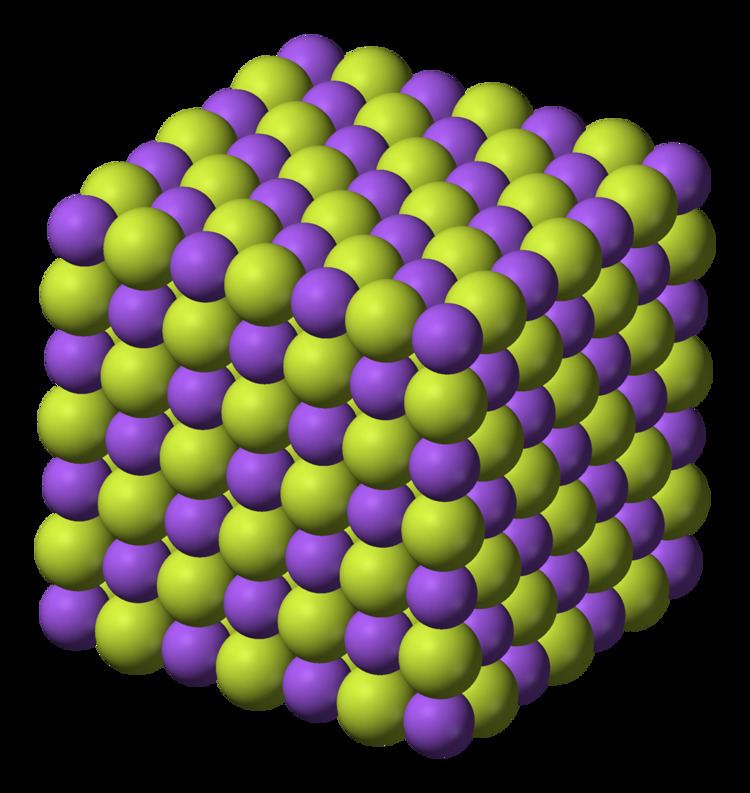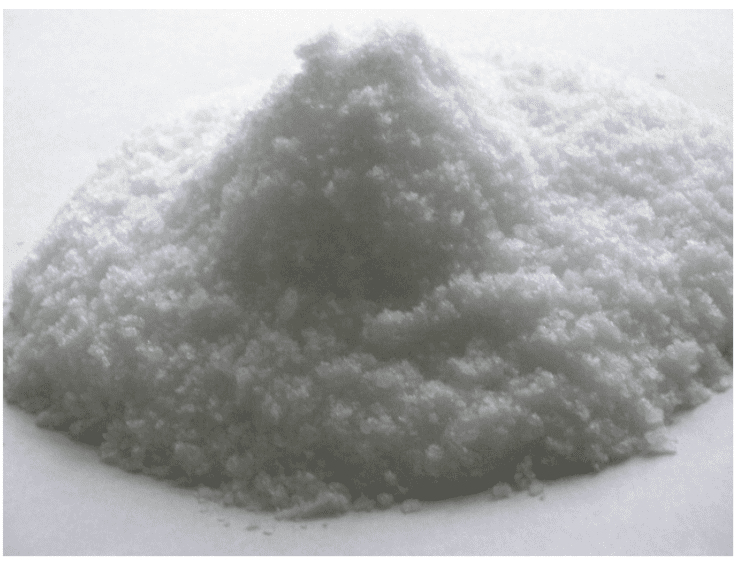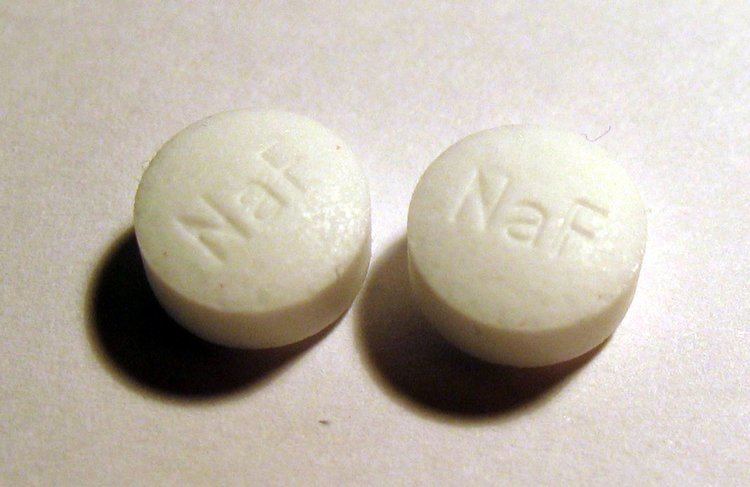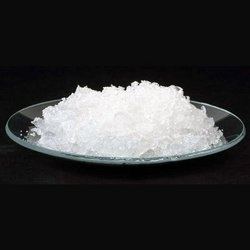Pronunciation /ˌsoʊdiəm ˈflʊəraɪd/ IUPAC ID Sodium fluoride Molar mass 41.98817 g/mol Boiling point 1,695 °C Soluble in Water | Related compounds Formula NaF Melting point 993 °C Density 2.56 g/cm³ | |
 | ||
Appearance White to greenish solid | ||
Sodium fluoride
Sodium fluoride (NaF) is a chemical compound and medication. As a medication it is primarily used to prevent tooth decay in children older than 6 months in areas where the drinking water is low in fluoride. Sodium fluoride is used as a liquid, pill, or paste by mouth with this use being known as fluoride therapy.
Contents
- Sodium fluoride
- Dental caries
- Osteoporosis
- Medical imaging
- Chemistry
- Other uses
- Safety
- Chemical structure
- Occurrence
- Production
- References
Normal doses may occasionally result in white marks on the teeth. Excessive doses can result in brown or yellow coloring of the teeth. It is believed to work mostly through direct contact with the teeth. Sodium fluoride is a colorless solid. It is most often made by mixing fluorosilicic acid with sodium hydroxide.

Sodium fluoride came into use to prevent tooth decay in the 1940s. It is on the World Health Organization's List of Essential Medicines, the most important medications needed in a basic health system. In the United Kingdom a typical month supply costs the NHS about 0.36 pounds. It is also commonly used for water fluoridation and added to toothpaste.

Sodium fluoride
Dental caries

Fluoride salts are often added to municipal drinking water (as well as certain food products in some countries) for the purposes of maintaining dental health. The fluoride enhances the strength of teeth by the formation of fluorapatite, a naturally occurring component of tooth enamel. Although sodium fluoride is used to fluoridate water and, indeed, is the standard by which other water-fluoridation compounds are gauged, hexafluorosilicic acid (H2SiF6) and its salt sodium hexafluorosilicate (Na2SiF6) are more commonly used additives in the U.S. Toothpaste often contains sodium fluoride to prevent cavities, although tin(II) fluoride is generally considered superior for this application.
Osteoporosis

Fluoride supplementation has been extensively studied for the treatment of postmenopausal osteoporosis. This supplementation does not appear to be effective; even though sodium fluoride increases bone density, it does not decrease the risk of fractures.
Medical imaging

In medical imaging, fluorine-18-labelled sodium fluoride (USP, sodium fluoride F18) is one of the oldest tracers used in positron emission tomography (PET), having been in use since the 1960s. Relative to conventional bone scintigraphy carried out with gamma cameras or SPECT systems, PET offers more sensitivity and spatial resolution. Fluorine-18 has a half-life of 110 min, which requires it to be used promptly once produced; this logistical limitation hampered its adoption in the face of the more convenient technetium-99m-labelled radiopharmaceuticals. However fluorine-18 is generally considered to be a superior radiopharmaceutical for skeletal imaging. In particular it has a high and rapid bone uptake accompanied by very rapid blood clearance, which results in a high bone-to-background ratio in a short time. Additionally the annihilation photons produced by decay of 18F have a high energy of 511-keV compared to 140-keV photons of 99mTc.
Chemistry
A variety of specialty chemical applications exist in synthesis and extractive metallurgy. It reacts with electrophilic chlorides including acyl chlorides, sulfur chlorides, and phosphorus chloride. Like other fluorides, sodium fluoride finds use in desilylation in organic synthesis. Sodium fluoride can be used to produce fluorocarbons via the Finkelstein reaction; this process has the advantage of being simple to perform on a small scale but is rarely used on an industrial scale due the existence of more effective techniques (e.g. Electrofluorination, Fowler process).
Other uses
Sodium fluoride is used as a cleaning agent (e.g., as a "laundry sour"). Sodium fluoride is used as a stomach poison for plant-feeding insects. Inorganic fluorides such as fluorosilicates and sodium fluoride complex magnesium ions as magnesium fluorophosphate. They inhibit enzymes such as enolase that require Mg2+ as a prosthetic group. Thus, fluoride poisoning prevents phosphate transfer in oxidative metabolism.
Safety
Fluorides, particularly aqueous solutions of sodium fluoride, are rapidly and quite extensively absorbed.
Fluorides interfere with electron transport and calcium metabolism. Calcium is essential for maintaining cardiac membrane potentials and in regulating coagulation. Large ingestion of fluoride salts or hydrofluoric acid may result in fatal arrhythmias due to profound hypocalcemia. Chronic over-absorption can cause hardening of bones, calcification of ligaments, and buildup on teeth. Fluoride can cause irritation or corrosion to eyes, skin, and nasal membranes.
The lethal dose for a 70 kg (154 lb) human is estimated at 5–10 g. Sodium fluoride is classed as toxic by both inhalation (of dusts or aerosols) and ingestion. In high enough doses, it has been shown to affect the heart and circulatory system. For occupational exposures, the Occupational Safety and Health Administration and the National Institute for Occupational Safety and Health have established occupational exposure limits at 2.5 mg/m3 over an eight-hour time-weighted average.
In the higher doses used to treat osteoporosis, plain sodium fluoride can cause pain in the legs and incomplete stress fractures when the doses are too high; it also irritates the stomach, sometimes so severely as to cause ulcers. Slow-release and enteric-coated versions of sodium fluoride do not have gastric side effects in any significant way, and have milder and less frequent complications in the bones. In the lower doses used for water fluoridation, the only clear adverse effect is dental fluorosis, which can alter the appearance of children's teeth during tooth development; this is mostly mild and is unlikely to represent any real effect on aesthetic appearance or on public health. A chronic fluoride ingestion of 1 ppm of fluoride in drinking water can cause mottling of the teeth (fluorosis) and an exposure of 1.7 ppm will produce mottling in 30–50 % of patients.
Chemical structure
Sodium fluoride is an ionic compound, dissolving to give separated Na+ and F− ions. Like sodium chloride, it crystallizes in a cubic motif where both Na+ and F− occupy octahedral coordination sites; its lattice spacing, approximately 462 pm, is somewhat smaller than that of sodium chloride.
Occurrence
The mineral form of NaF, villiaumite, is moderately rare. It is known from plutonic nepheline syenite rocks.
Production
NaF is prepared by neutralizing hydrofluoric acid or hexafluorosilicic acid (H2SiF6), byproducts of the reaction of fluorapatite (Ca5(PO4)3F) (from phosphate rock) from the production of superphosphate fertilizer. Neutralizing agents include sodium hydroxide and sodium carbonate. Alcohols are sometimes used to precipitate the NaF:
HF + NaOH → NaF + H2OFrom solutions containing HF, sodium fluoride precipitates as the bifluoride salt NaHF2. Heating the latter releases HF and gives NaF.
HF + NaF ⇌ NaHF2In a 1986 report, the annual worldwide consumption of NaF was estimated to be several million tonnes.
